Welcome to our guide on how to get a child to sleep with the light off. As parents ourselves, we understand the importance of a good night’s sleep for both the child and the parents.
However, we also understand that bedtime fears can significantly hinder achieving this goal.
That’s why we’ve put together this resource to provide you with tips and strategies to help your child sleep without a light.
Not only can bedtime fears be stressful for children, but they can also have a significant impact on their overall well-being.
Restful sleep is essential for a child’s physical and mental development, and any disruption can have serious consequences.
Therefore, it is vital to address any concerns your child may have and help them overcome their fear of sleeping without a light.
Key points to think about:
- Helping your child sleep without a light is essential for their well-being.
- Bedtime fears can have a significant impact on a child’s sleep quality.
- Ensuring a child’s restful sleep is vital for their physical and mental development.
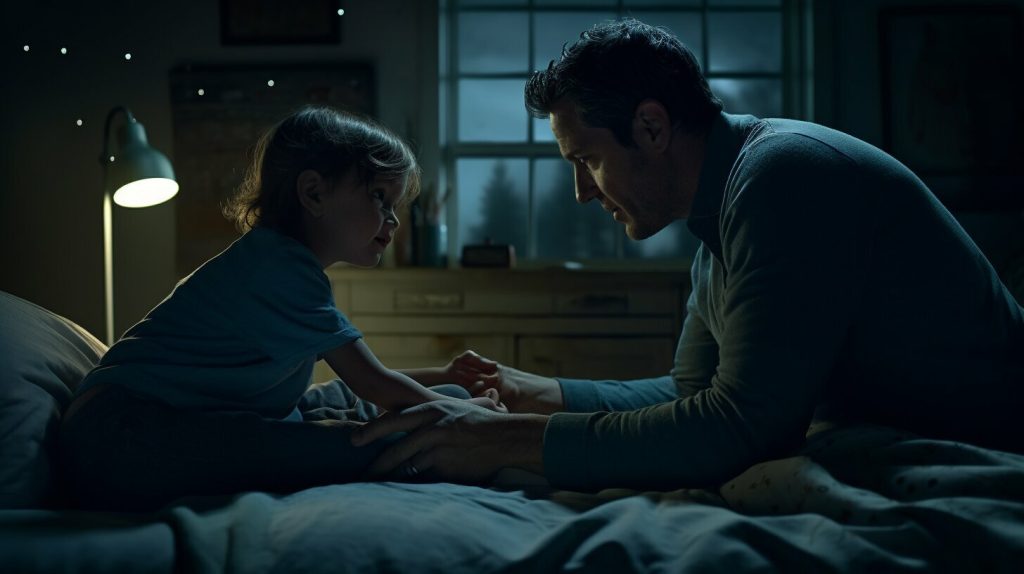
Understanding the Fear of Darkness
As parents, it’s not uncommon to hear complaints from our children about being scared of the dark.
While it may seem like a small issue, this fear can actually have a significant impact on their ability to get a good night’s rest.
Understanding the fear of darkness is the first step in helping your child overcome this fear and sleep soundly in a dark room.
Why Children Are Afraid of Sleeping in the Dark
The fear of darkness is a common fear among children, and there can be several reasons why they might be afraid of sleeping in a dark room.
For some children, it’s simply a fear of the unknown – they can’t see what’s happening around them and that can be scary.
For others, it may be a fear of monsters or other imaginary creatures hiding in the shadows.
It’s important to remember that these fears are real to your child, no matter how irrational they may seem to you.
As parents, it’s our job to acknowledge these fears and help our children work through them.
Strategies to Help Your Child Overcome Fear of Darkness
There are several strategies you can use to help your child overcome their fear of darkness.
Here are a few to consider:
- Start small: If your child is very afraid of the dark, it’s important to take small steps towards sleeping without a light. For example, you could start by dimming the lights in their room a little bit each night until they get used to the darkness.
- Offer reassurance: Let your child know that they are safe and that you are there for them. Consider using a comforting nightlight or a favourite stuffed animal to help ease their anxiety.
- Encourage relaxation: Incorporate relaxing activities into your child’s bedtime routine, such as reading a book or listening to calming music. This can help them feel more calm and comfortable as they drift off to sleep.
By gradually easing your child into sleeping without a light and providing reassurance and relaxation strategies along the way, you can help them overcome their fear of darkness and get a restful night’s sleep.
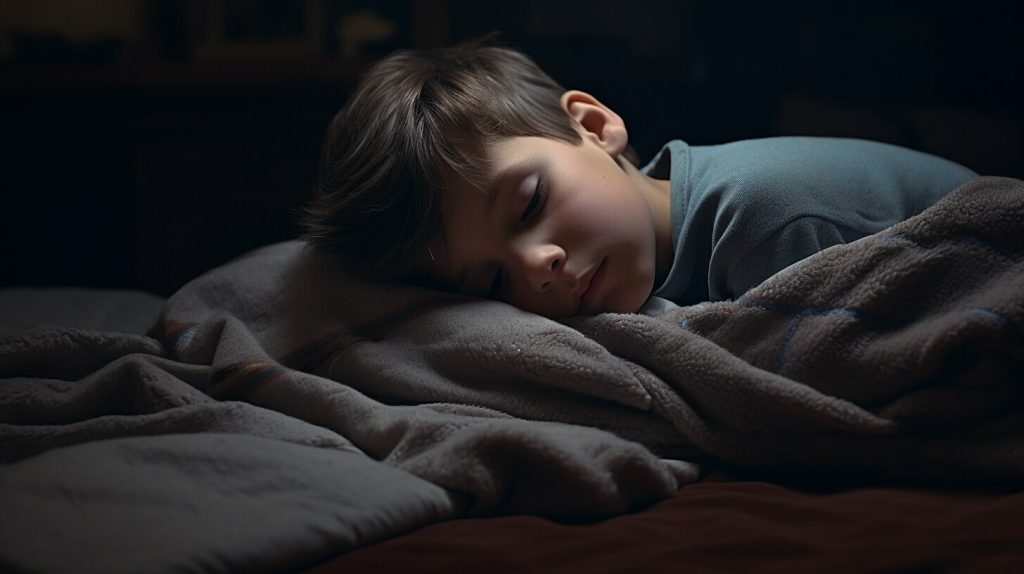
Establishing a Bedtime Routine
Children thrive on predictability and routine, which is why establishing a consistent bedtime routine is crucial for promoting healthy sleep habits.
A calming and predictable routine can help ease a child’s anxiety and make it easier for them to fall asleep without needing a light on.
Here are some practical tips and strategies for creating a bedtime routine:
- Set a consistent bedtime and wake-up time every day, including weekends. This helps regulate your child’s biological clock and promotes better sleep.
- Start winding down at least 30 minutes before bedtime. Encourage quiet activities such as reading a book or taking a warm bath.
- Turn off all electronics, including phones, tablets, and televisions, at least an hour before bedtime. The blue light emitted by these devices can interfere with your child’s natural sleep cycle.
- Choose calming activities to do together in the final 15 minutes before bedtime, such as telling a story or doing a relaxation exercise.
Remember, the goal of a bedtime routine is to create a calm and peaceful environment that helps your child feel relaxed and comfortable.
Consistency is key, so try to follow the routine as closely as possible every night.
Creating a predictable and calming bedtime routine can help children feel more comfortable sleeping without a light.
Magical Deep Sleep Music 🎵 Soothing Bedtime Music For Your Child
Creating a Dark Sleep Environment
Creating a dark sleep environment is crucial to help your child sleep without a light.
Not only does it promote a relaxing atmosphere, but it can also help alleviate fears and anxieties that children may have about sleeping in the dark.
Here are some tips to create a calming and dark sleep environment for your child:
| Tip | Description |
|---|---|
| Use blackout curtains | Invest in blackout curtains to eliminate any light from street lamps or outdoor lights. This will ensure that your child’s room is as dark as possible, promoting deeper and more restful sleep. |
| Remove electronic devices | Make sure any electronic devices in your child’s room are turned off or removed, as the light they emit can interfere with sleep quality. This includes TVs, phones, and tablets. |
| Utilize soft nightlights if necessary | If your child is still uncomfortable with complete darkness, consider using a soft nightlight to provide a calming glow in their room. Choose a warm, amber light rather than a bright white light, which can be too stimulating. |
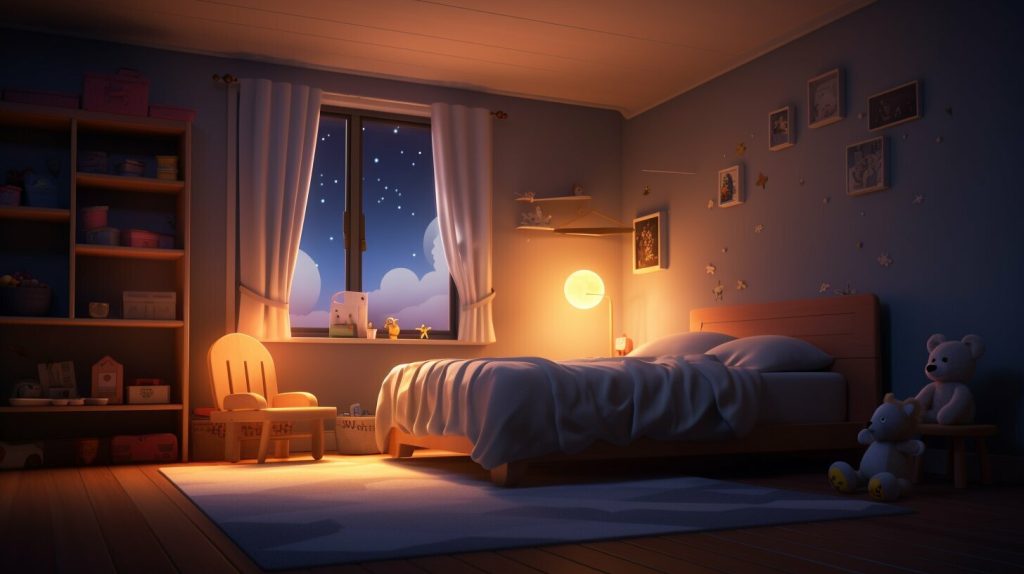
Remember, creating a dark sleep environment is an important step in establishing healthy sleep habits for your child.
Relaxation Techniques and Soothing Methods
In order to help your child feel safe and calm before bedtime, a variety of relaxation techniques and soothing methods can be used.
These activities can not only help reduce a child’s fear of sleeping in the dark but also promote relaxation and better sleep quality.
Reading Bedtime Stories
One effective method for promoting relaxation before bedtime is reading bedtime stories. This can help calm a child and distract them from any fears or worries they may have. It’s also a great opportunity for quality bonding time with your child.
Tip: Choose books with a calming or positive message to promote a peaceful and restful sleep environment.
Deep Breathing Exercises
Practising deep breathing exercises can also be a helpful relaxation technique for children.
Encourage your child to take slow, deep breaths while imagining themselves in a peaceful or calming environment. This can help ease anxiety and promote relaxation.
Music or White Noise
Using gentle music or white noise can also help soothe a child before bedtime.
Soft instrumental music or white noise machines can create a peaceful sleep environment and drown out any external noises that may be disruptive to sleep.

Guided Imagery
Guided imagery involves visualizing a calming or peaceful scenario, such as a peaceful beach or a sunny meadow.
This can help a child relax and feel safe before bedtime. You can guide your child through the imagery or use pre-recorded guided meditation scripts.
Progressive Muscle Relaxation
Progressive muscle relaxation involves tensing and relaxing different muscle groups in the body, one at a time.
This technique can help release tension and promote relaxation throughout the body.
Tip: Encourage your child to focus on their breath while practicing progressive muscle relaxation to help promote relaxation and calm.
Gradual Transitioning to a Dark Room
Transitioning a child to sleep without a light is a process that requires patience and consistency.
Taking small steps can make a big difference in reducing a child’s fear of sleeping in the dark and encouraging them to feel more comfortable in a dark sleep environment.
One effective strategy is to gradually increase the darkness of the room over time. Start by dimming the lights slightly for a few nights and gradually work towards turning off the light completely.
This can help a child adjust to the change and feel more comfortable as they become more accustomed to the dark.
It is also important to offer reassurance and support throughout the process.
Let your child know that they are safe and secure, and provide comfort objects such as a favourite stuffed animal or blanket to help them feel more at ease.
Additionally, try incorporating relaxation techniques and soothing methods into your child’s bedtime routine.
Reading a bedtime story, practising deep breathing exercises, or using calming music or white noise can help promote a sense of calm and relaxation before bedtime.
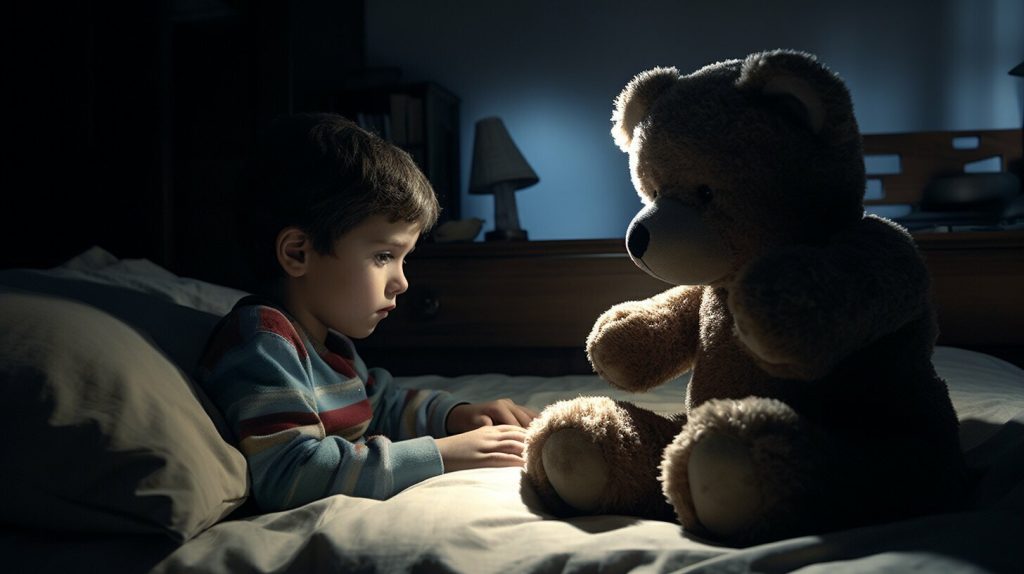
Remember, the key is to be patient and consistent. Each child may react to the process differently, so it’s important to be flexible and adjust as needed.
Promoting Healthy Sleep Patterns
Establishing healthy sleep habits is essential for your child’s overall well-being and development.
Here are some tips to promote natural sleep patterns:
- Encourage your child to play and exercise during the day, as physical activity can help them sleep better at night.
- Create a comfortable sleep environment by ensuring the temperature is cool and the room is quiet and conducive to sleep.
- Limit screen time before bed, as the blue light emitted by electronic devices can interfere with natural sleep patterns.
- Establish a consistent sleep schedule, with regular bedtimes and wake-up times, even on weekends.
By promoting healthy sleep patterns, you can help your child feel more rested and refreshed, and improve their overall health and well-being.
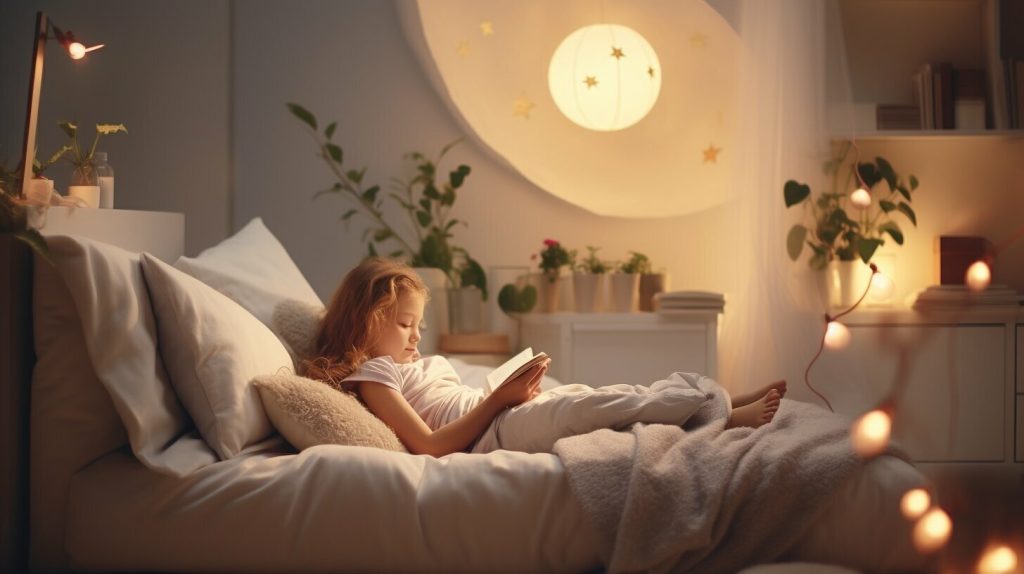
Reducing Anxiety at Bedtime
Bedtime anxiety can be a common issue for children. It can be a significant barrier to sleeping without a light.
Night-time fears can lead to difficulty sleeping, which can cause behavioural and emotional issues.
There are many strategies that can be used to reduce anxiety at bedtime, including creating a soothing bedtime routine, limiting stimulating activities before bed, and using relaxation techniques.
A soothing bedtime routine can help to create a calming atmosphere and prepare a child for sleep.
This can include activities such as taking a warm bath, reading a bedtime story, or using a relaxation technique like deep breathing exercises. A consistent routine can provide a sense of security and predictability, which can ease anxiety.
Limiting stimulating activities before bed is another way to reduce anxiety at bedtime. This can include limiting screen time, avoiding exciting games, and limiting the consumption of caffeine or sugar.
Stimulating activities can make it harder for a child to relax and fall asleep, which can elevate anxiety and make sleeping without a light more difficult.
Incorporating relaxation techniques into the bedtime routine can also be effective in reducing anxiety.
These techniques can include using gentle music or white noise, practising guided relaxation exercises, or visualisation techniques.
These techniques can help to calm the mind and relax the body, which can improve the chances of falling asleep without a light.
It’s important to remember that reducing anxiety at bedtime is a gradual process. It may take time to find the right combination of strategies that work for your child.
It’s essential to be patient, supportive, and consistent in trying different techniques.

Tips for Helping Your Child Sleep Better
At times, getting children to sleep without a light can be a challenge.
However, with the right strategies in place, you can make it easier for your child to fall asleep in the dark and enjoy the benefits of restful sleep.
Consider the following tips:
- Make sure your child gets plenty of physical activity during the daytime. This can help promote better sleep at night.
- Create a comfortable sleep environment, featuring a dark and cool room. Utilize soft bedding and comfortable pillows to help your child feel relaxed and secure.
- Establish consistent sleep and wake times, even on weekends. This can help regulate your child’s sleep patterns and promote better sleep quality.
- Limit screen time before bed, as electronic devices emit blue light that can interfere with sleep. Encourage calming and relaxing activities, such as reading a book or listening to gentle music.
- If your child is afraid of the dark, gradually introduce the concept of sleeping without a light. Start by dimming the lights and gradually increasing the darkness over time.
- Consider using a white noise machine or a fan to create a calming atmosphere that can help your child fall asleep more easily.
Remember, it’s important to approach the process of helping your child sleep without a light with patience and consistency.
Keep in mind that every child is different, and what works for one may not work for another.
By implementing these tips and strategies, you can help improve your child’s sleep habits and overall well-being.
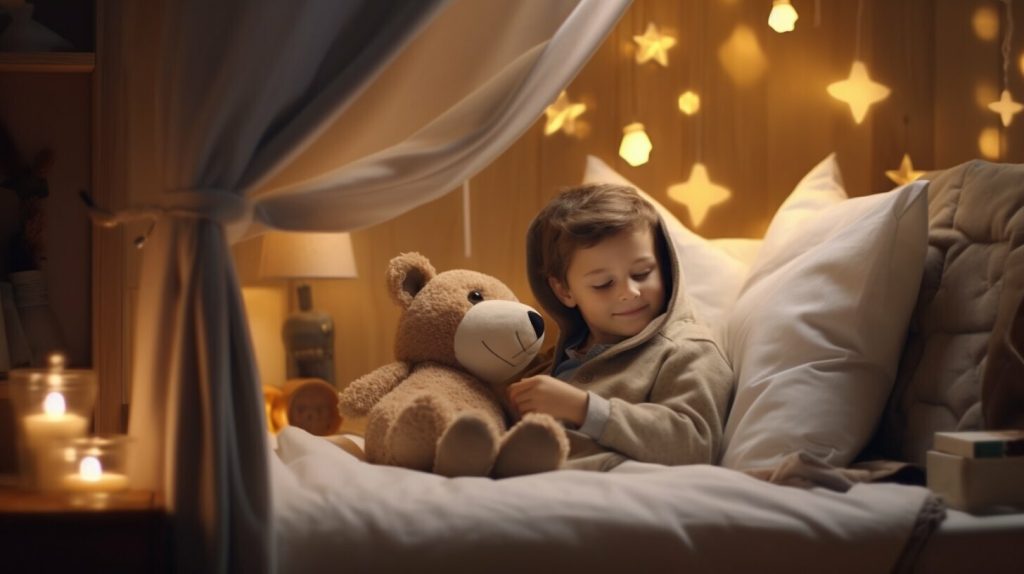
How to Get A Child to Sleep with Light Off: Final Thoughts
Helping a child learn to sleep without a light can be a process that requires patience, persistence, and creativity.
By understanding the fear of darkness and establishing a consistent bedtime routine, parents and caregivers can create a calming sleep environment that promotes restful sleep.
Additionally, promoting relaxation techniques and gradually transitioning to a dark room can help children feel more comfortable and confident in their ability to sleep without a light.
It’s important to remember that every child is unique and may require different strategies and approaches.
However, by maintaining consistent sleep patterns, promoting healthy sleep habits, and reducing anxiety at bedtime, parents and caregivers can help their children sleep soundly and comfortably, without the need for a nightlight or other source of light.
Incorporating these tips and techniques into a daily routine can take time and effort, but the benefits of restful sleep are well worth the investment.
With patience, persistence, and a positive attitude, parents and caregivers can support their children in developing healthy sleep patterns that will benefit them for years to come.
FAQs
Q: How can I help my child sleep with the light off?
A: Helping your child sleep with the light off can be achieved by creating a calming and dark sleep environment, establishing a consistent bedtime routine, and utilizing relaxation techniques and soothing methods.
Q: Why are children afraid of sleeping in the dark?
A: Children may be afraid of sleeping in the dark due to the fear of the unknown, imagination, or past experiences. It is a common fear that can be overcome with understanding and gradual exposure.
Q: How can I establish a bedtime routine for my child?
A: Establishing a bedtime routine involves creating a consistent schedule, incorporating calming activities such as reading or relaxation exercises, and providing reassurance and comfort to your child.
Q: What can I do to create a dark sleep environment for my child?
A: Creating a dark sleep environment can be achieved by using blackout curtains, removing electronic devices, and utilizing soft nightlights if necessary. It is important to promote a calming atmosphere that is conducive to restful sleep.
Q: What relaxation techniques and soothing methods can I use to help my child sleep without lights?
A: Techniques such as reading bedtime stories, practising deep breathing exercises, and using gentle music or white noise can help children feel safe and calm before bedtime, promoting better sleep without lights.
Q: How can I gradually transition my child to sleep without a light?
A: Gradually transitioning your child to sleep without a light involves taking small steps, increasing the darkness in the room over time, and providing reassurance and support throughout the process.
Q: What can I do to promote healthy sleep patterns in my child?
A: Promoting healthy sleep patterns involves maintaining consistent sleep schedules, limiting screen time before bed, and utilizing relaxation techniques to encourage better sleep quality.
Q: How can I reduce my child’s anxiety at bedtime?
A: Reducing anxiety at bedtime can be achieved by creating a soothing pre-bedtime routine, using comfort objects, and engaging in calming activities to help alleviate fears and worries.
Q: What are some tips for helping my child sleep better?
A: Additional tips for helping your child sleep better include regular exercise, creating a comfortable sleep environment, and maintaining consistent sleep-wake times.

